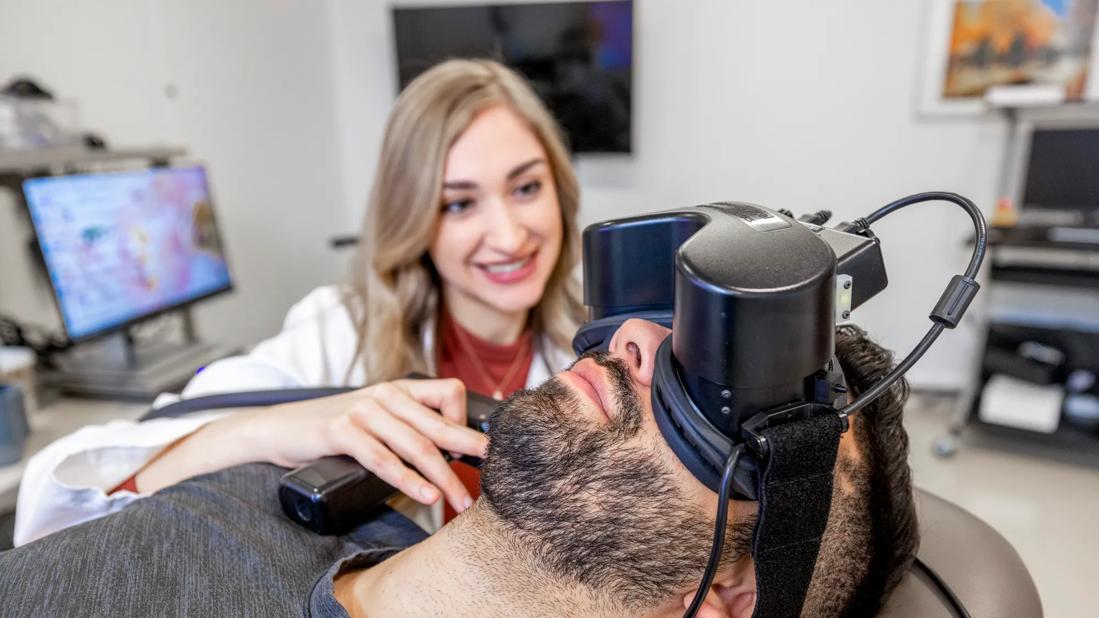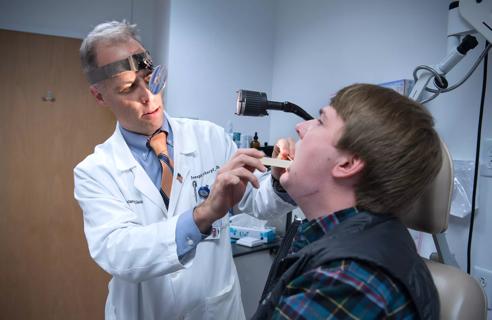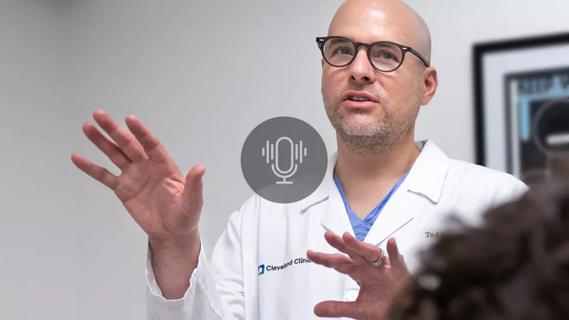Evaluates function across vestibular system

“We must be more dynamic in our testing, to see how the complete vestibular system is working and how the brain is registering information,” says Julie Honaker, PhD, Director of the Vestibular and Balance Disorders Laboratories within Cleveland Clinic’s Head and Neck Institute. “Testing must not only be more thorough, but personalized for each patient.”
Advertisement
Cleveland Clinic is a non-profit academic medical center. Advertising on our site helps support our mission. We do not endorse non-Cleveland Clinic products or services. Policy
To provide more accurate and complete diagnoses of vestibular and balance disorders, Cleveland Clinic has introduced a more sophisticated test protocol to evaluate every structure and reflex pathway in the vestibular system.
Earlier protocols evaluated only one mechanism in the inner ear — the horizontal semicircular canal — to get a general overview of central and peripheral vestibular pathways, says Dr. Honaker. The new protocol evaluates all semicircular canals and gravity-sensing organs in each ear, plus all connections between those organs and how they integrate with the brain and body. In addition, the new test protocol considers how impairments to the vestibular system affects a patient’s everyday life.
“Traditional vestibular assessment is like a hearing test done only at low frequency,” Dr. Honaker says. “A patient may test normal, but maybe the right test wasn’t conducted on the right mechanism. With our advanced, patient-specific model of testing, we look across the vestibular system to tell how the patient is truly functioning.”
In addition to conventional VNG testing — which examines the central vestibulo-ocular pathway, vestibulo-ocular reflex (calorics) and positional nystagmus — and rotational chair testing, Cleveland Clinic’s new testing protocol can incorporate:
Advertisement
“Combinations of these measures can evaluate each organ and each branch of the vestibular nerve to give a holistic view of how the vestibular system is working,” Dr. Honaker explains.
Rather than perform every test on every patient, a patient’s case history determines which tests will be conducted and in which order.
Evidence-based research, patient feedback and Dr. Honaker’s own experience have helped Cleveland Clinic develop more intensive questionnaires to explore patient symptoms and effects on daily living — including history of migraine, motion intolerance and falls.
“Best practices indicate which tests will be most valuable for certain circumstances,” says Dr. Honaker. “For example, a patient with motion intolerance may not be able to tolerate rotational chair testing. If we suspect a particular diagnosis, we will customize testing even more.”
Patients with suspected Meniere’s syndrome may undergo mCTSIB, VEMP, vHIT and VNG testing. Patients with suspected benign paroxysmal positional vertigo (BPPV) may undergo only positional testing. Patients with other suspected conditions follow other customized care paths.
A 42-year-old male presented with major complaints of imbalance. Symptoms occurred at any time of day, only with head movement. Onset of symptoms had been gradual. Due to a perforated eardrum, the patient could not complete VNG testing involving bithermal caloric irrigation. As a result, vHIT was conducted, revealing dysfunction in all six of the patient’s semicircular canals. Rotational chair testing evaluated low-frequency response and clinically correlated vHIT findings. A traditional vestibular assessment wouldn’t have been able to diagnose this patient, because it would have provided no information on high-frequency response of the horizontal canal or function of the other semicircular canals.
Advertisement
Another patient presented with long-standing, constant perceptional dizziness. She blamed the dizziness for academic struggles that caused her to drop out of graduate school. A thorough case history indicated that both physiologic evaluation and functional assessment of her vestibular system was necessary. First, mCTSIB testing evaluated her functional ability to maintain an upright stance during four postural control conditions (standing on a firm and foam surface with eyes open and closed). Second, DVA testing evaluated function of her vestibular-ocular reflex. Both measures showed adequate functioning of her balance system, specifically her vestibular organs. A traditional vestibular assessment wouldn’t have provided this snapshot of her capabilities — nor redirected specialists to the anxiety and other stressors underlying her symptoms.
A more thorough, more personalized vestibular testing protocol facilitates more accurate diagnoses and, therefore, more effective treatment planning, says Dr. Honaker.
Physical therapy is the most common way to manage vestibular conditions, she notes. Knowing the precise cause of symptoms is important for therapists to prescribe appropriate treatments.
“There are only a handful of other medical centers in the U.S. that offer comprehensive vestibular testing like this,” Dr. Honaker says. “We are able to pinpoint the cause in the most challenging cases of dizziness or imbalance — even in patients whose conventional testing came back normal.”
Cleveland Clinic’s Vestibular and Balance Disorders Laboratories are at three locations around Northeast Ohio. Head and Neck Institute audiologists, nurses and vestibular testing technicians serve an average of 130 patients per month with all forms of dizziness or imbalance, including lightheadedness, disorientation and spinning sensation. Most patients are referred by primary care physicians after initial evaluations rule out cardiovascular, neurological and other potential causes of dizziness. In addition to sophisticated testing and diagnosis, facilities offer physical therapy for vestibular rehabilitation.
Advertisement
Advertisement

A deep dive into the evolution of surgical sleep therapy

A commitment to sharing expertise has fostered a global exchange of ideas

How a new clinic is helping to streamline evaluations for patients

A multidisciplinary approach and individualized plan of care are imperative

Insight on larynx disorders and treatments

Novel procedures provide options for patients who can’t tolerate CPAP

Research on children with UHL explores the quality-of-life benefits and outcomes of cochlear implants

A look at how custom-fitted oral appliances work and when they’re a good fit for patients